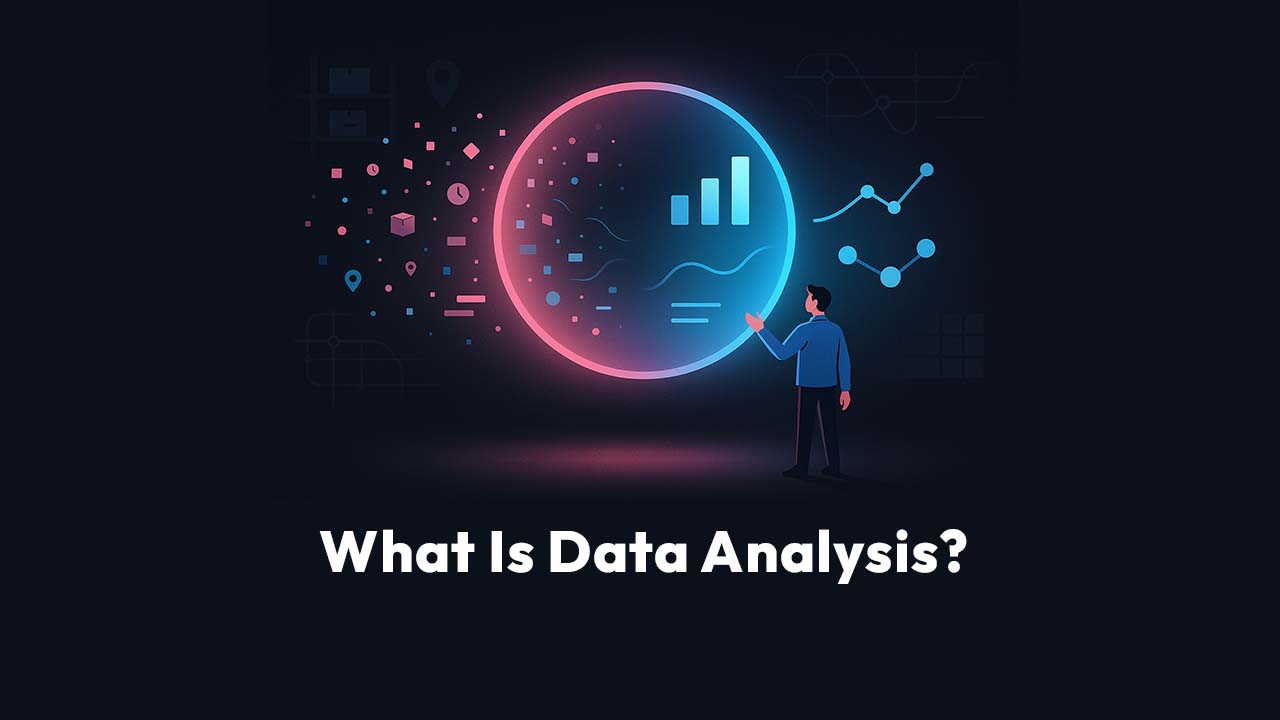What is data analysis? In simple terms, data analysis is the process of turning raw numbers from your systems into decisions you can act on with confidence. You collect data, clean it, look for patterns, and translate those patterns into actions that improve operations, reduce risk, and grow revenue.
Data analysis is not just a technical exercise. It is how your business answers everyday questions like: “Which orders are at risk?”, “Which locations are bleeding margin?”, and “What should we fix first this quarter?”
Let’s walk through how it really works in an operations context, step by step.
What is data analysis?
Data analysis is the structured process of inspecting, cleaning, transforming, and modeling business data to answer specific questions and support better decisions. It turns fragmented information from systems like ERP, WMS, CRM, and spreadsheets into clear insights about performance, risks, and opportunities across your operations.
Expanded explanation
When you ask “What is data analysis?” as an operations leader, you are really asking: “How do I go from a mess of reports and exports to clear, prioritized actions?”
Data analysis sits in the middle of that journey. It connects:
- The questions your team has about operations
- The data scattered across your tools
- The actions you take to fix problems or scale what works
At its best, data analysis shortens the distance between “What is going on?” and “Here’s what we’re doing about it.”
Why operations leaders should care
Here is what effective data analysis can do for you:
- Expose hidden bottlenecks in order processing, fulfillment, or support
- Reduce fire drills by spotting leading indicators of problems before they blow up
- Prioritize investments using real numbers instead of internal politics
- Align teams around a single version of the truth
A surprising fact: many organizations already have more than enough data. Their real problem is not collection. It is the lack of a reliable, repeatable way to analyze that data and act on it.
How does data analysis work in day-to-day operations?
Data analysis follows a repeatable loop: start with a clear question, gather relevant data, clean and prepare it, explore for patterns, apply the right techniques, then communicate insights and decide what to do. In operations, this loop runs continuously, guiding staffing, inventory, SLAs, and process improvements.
What are the core steps of data analysis?
The core steps of data analysis are: define the question, collect data, clean and prepare it, explore patterns, apply analytic methods, and communicate results with clear recommendations. Skipping any of these steps usually leads to misleading conclusions or analysis that no one trusts.
Here is a practical breakdown you can share with your team:
- Define the operational question
Examples:
- “Why did on-time delivery drop last quarter?”
- “Which customers are driving support volume?”
- “Where are we losing margin in the network?”
- “Why did on-time delivery drop last quarter?”
- Collect the right data
Pull from systems that touch your question:
- ERP and WMS for orders, inventory, lead times
- CRM and support tools for tickets and customer behavior
- Finance systems for revenue, discounts, and costs
- ERP and WMS for orders, inventory, lead times
- Clean and prepare the data
This is where most time is actually spent:
- Fix inconsistent naming (e.g., “ATL DC”, “Atlanta DC”)
- Remove duplicates and obvious errors
- Standardize time zones, units, and currencies
- Join datasets (orders to shipments, shipments to returns, etc.)
- Fix inconsistent naming (e.g., “ATL DC”, “Atlanta DC”)
- Explore and visualize
Now you start to see the story:
- Trend lines over time
- Breakdowns by region, channel, product, or customer segment
- Outliers that point to process gaps or failures
- Trend lines over time
- Apply the right methods
Depending on the question:
- Simple comparisons and ratios
- Statistical tests
- Forecasting models
- Scenario analysis (if we do X, what changes?)
- Simple comparisons and ratios
- Translate into decisions
This is where many teams fail. They stop at charts.
Instead, define:
- What we will change
- Who owns it
- When we will revisit the numbers
- What we will change
Related information: A real-world example
Imagine your on-time delivery rate dropped from 97 percent to 92 percent.
- Question: “What changed in the last 60 days?”
- Data: carrier performance, warehouse pick times, order volume, backlog, weather events
- Analysis: segment on-time delivery by carrier, region, and warehouse; correlate spikes with specific carriers and cut-off times
- Decision: shift volume away from the underperforming carrier, adjust cut-off times, and monitor for two weeks
That is data analysis in action. Not a dashboard for its own sake, but a direct path from question to operational change.
What are the main types of data analysis?
What are the main types of data analysis for operations?
The main types of data analysis in operations are descriptive, diagnostic, predictive, and prescriptive. Together, they help you understand what happened, why it happened, what might happen next, and what you should do about it. Mature operations teams use all four, not just rear-view reporting.
Data analysis types categorize how deeply you use your data. Descriptive analysis summarizes past performance. Diagnostic analysis digs into causes. Predictive analysis estimates future outcomes using patterns in historical data. Prescriptive analysis recommends actions, often simulating scenarios to show which decisions will likely produce the best operational results.
Comparison table
Where most teams get stuck
Many organizations stay stuck at descriptive. They have plenty of dashboards and reports, but very little understanding of “why” or “what next.”
If you want to move toward predictive and prescriptive analysis, you do not need a PhD to start. You do need:
- Clean historical data
- Clear definitions of your metrics
- A culture that actually tests and implements recommendations
How do real companies use data analysis in operations?
Operations teams use data analysis to manage inventory, staffing, delivery performance, quality, and customer experience. They turn raw logs and transactions into capacity plans, SLAs, and improvement roadmaps. Done well, data analysis becomes part of the weekly operating rhythm, not a one-time project.
Example 1: Inventory and demand signals
A mid-market ecommerce company keeps running out of their best-selling product in one region.
- Descriptive: they see stockouts spiking in that region.
- Diagnostic: by analyzing orders by channel, they discover a new marketplace listing drove a sudden demand spike.
- Predictive: they build a simple model that flags similar surges early.
- Prescriptive: they adjust reorder points and safety stock for products and regions with volatile demand.
Outcome: fewer stockouts, happier customers, less lost revenue.
Example 2: Support volume and product quality
A SaaS company sees support tickets climbing for “slow performance.”
- Descriptive: tickets tagged “performance” have doubled in 45 days.
- Diagnostic: a deeper look shows the spike is concentrated in customers using a specific integration.
- Predictive: basic trend projections show that if nothing changes, ticket volume will overwhelm the team next quarter.
- Prescriptive: the team prioritizes a fix for that integration and proactively communicates with affected customers.
Outcome: lower ticket volume, better NPS, fewer surprise escalations to the executive team.
Example 3: Logistics and carrier performance
A distributor operates multiple warehouses with different carriers.
- Descriptive: on-time delivery varies widely by carrier and lane.
- Diagnostic: analysis reveals a particular carrier has chronic delays on a few lanes during peak season.
- Prescriptive: they reallocate volume, change cut-off times, and negotiate SLA-backed penalties.
Outcome: more reliable delivery and better leverage in carrier negotiations.
Each example follows the same pattern: ask a sharp question, analyze your data, decide, act, review.
How to analyze your data when you are not a data scientist
How can operations leaders analyze data without being technical experts?
You do not need to be a data scientist to analyze your data effectively. You need clear questions, trustworthy metrics, consistent data sources, and simple tools your team will actually use. Start small, focus on one problem at a time, and build a repeatable routine instead of a heroic one-off project.
A simple framework: how to analyze your data
Use this as a checklist the next time you feel overwhelmed by dashboards.
- Clarify the decision first
- What decision are you trying to make?
- Example: “Should we open a second shift at the distribution center?”
- What decision are you trying to make?
- Write one or two key questions
- “What is our current capacity utilization?”
- “How often are we missing SLA because of capacity?”
- “What is our current capacity utilization?”
- List the data you actually need
- Order volume by hour and day
- Processing time per order
- SLA performance by time of day
- Order volume by hour and day
- Pull and clean just that data
- Use spreadsheets or simple BI tools
- Standardize date formats, product IDs, and location names
- Remove outliers that are clearly errors (e.g., negative processing time)
- Use spreadsheets or simple BI tools
- Visualize before you model
- Plot volume and SLA performance by hour/day
- Highlight times when SLAs drop below target
- Plot volume and SLA performance by hour/day
- Translate patterns into options
- Option A: add a second shift
- Option B: move some volume to earlier in the day
- Option C: adjust cut-off times
- Option A: add a second shift
- Document the decision and follow-up
- What did you decide? Why?
- When will you revisit the data to see if it worked?
- What did you decide? Why?
This is how to analyze your data in a way that feels practical, not academic. The goal is not a perfect model. The goal is a better decision next week.
How do I implement answer engine optimization on my website?
You asked for AEO as part of your content architecture, so let’s treat this as one of your related “cluster” questions.
How do I implement answer engine optimization on my website?
To implement answer engine optimization, structure your content around clear questions and concise answers, like we are doing here. Use headings phrased as questions, provide 40–60 word direct answers, add lists and tables, and mark up key sections with schema so search engines can quickly extract and surface your responses.
Expanded explanation
Answer engines (search, AI assistants, voice interfaces) are increasingly looking for:
- Clear question-focused headings (“What is data analysis?”, “How does X work?”)
- Short, self-contained answers that can stand alone
- Supporting context, examples, and related questions to signal depth
From a data analysis perspective, think of AEO as making your content “machine-readable” and “machine-analyzable.” The structure of your articles should make it easy for both humans and algorithms to understand what each section is about.
Related information: data-driven AEO
To improve AEO using data analysis:
- Analyze your search queries
- Look for question phrases (“how do I”, “what is”, “why does”)
- Look for question phrases (“how do I”, “what is”, “why does”)
- Group them into themes
- Data analysis, operations, forecasting, SLAs, etc.
- Data analysis, operations, forecasting, SLAs, etc.
- Create content clusters
- One in-depth guide (like this one) plus multiple shorter posts answering related questions
- One in-depth guide (like this one) plus multiple shorter posts answering related questions
- Measure outcomes
- Track impressions and clicks for featured snippets and Q&A-style results
- Track impressions and clicks for featured snippets and Q&A-style results
- Iterate based on performance
- Refine headings and answers where your content appears but does not yet win the click
FAQ
What is data analysis in simple terms?
Data analysis is the practice of looking at your business data to answer specific questions. You organize the numbers, spot patterns, and decide what to do differently because of what you see. In operations, that means using data to run smoother processes, not just to fill reports.
What is the difference between data analysis and reporting?
Reporting shows you what happened. Data analysis explains why it happened and what to do next. A monthly SLA report is reporting. Digging into which lanes, carriers, or shifts cause SLA failures, then changing your process to fix them, is data analysis.
How much data do I need to start?
You do not need “big data” to get value. You can start with:
- Six to twelve months of transaction data
- A reliable way to tie events together (order to shipment, shipment to return)
- A consistent set of definitions and metrics
The biggest gains usually come from analyzing the data you already have more thoughtfully, not from collecting more.
How long does it take to see results from data analysis?
You can get useful insights in days or weeks if you focus on one narrow question. For example, identifying your worst-performing carrier lane can happen in a single working session. Larger initiatives, like redesigning your network or staffing model, may take months of iterative analysis and testing.
How do I build a data analysis habit inside my operations team?
Start small and make it routine:
- Pick one key metric (for example, on-time delivery or capacity utilization).
- Review it weekly with a simple, consistent view.
- Ask “why” for both good and bad weeks.
- Capture one action item from each review.
- Revisit previous actions to see if they worked.
Over time, your team stops treating data analysis as a one-off “project” and starts using it as the backbone of how you run the business.
Bringing it all together
If you remember nothing else, remember this:
- What is data analysis? It is the link between your questions and your decisions.
- How to analyze your data? Start with a decision, not with a tool. Keep the process small, focused, and repeatable.
- Why it matters? Because in operations, guessing is expensive. Data-informed decisions compound over time.
You already own the data. The next step is building a culture and a simple process that makes data analysis part of how you work every week.
If you want, I can help you turn this framework into a one-page playbook for your team’s next operations review.








.png)